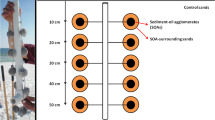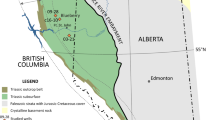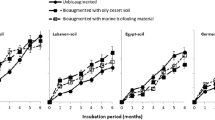Abstract
Biodegradation of crude oil by bacterial activity—which has occurred in the majority of the Earth's oil reserves1—is known to reduce greatly the quality of petroleum in reservoirs2. For economically successful prospecting for oil, it is therefore important to understand the processes and conditions in geological formations that lead to oil biodegradation. Although recent studies speculate that bacterial activity can potentially occur up to temperatures as high as 150 °C (refs 3, 4), it is generally accepted that effective petroleum biodegradation over geological timescales generally occurs in reservoirs with temperatures below 80 °C (ref. 2). This appears, however, to be at odds with the observation that non-degraded oils can still be found in reservoirs below this temperature. Here we compile data regarding the extent of oil biodegradation in several oil reservoirs, and find that the extensive occurrence of non-biodegraded oil in shallow, cool basins is restricted to those that have been uplifted from deeper, hotter regions of the Earth. We suggest that these petroleum reservoirs were sterilized by heating to a temperature around 80–90 °C during deep burial, inactivating hydrocarbon-degrading organisms that occur in the deep biosphere. Even when such reservoirs are subsequently uplifted to much cooler regions and filled with oil, degradation does not occur, implying that the sterilized sediments are not recolonized by hydrocarbon-degrading bacteria.
This is a preview of subscription content, access via your institution
Access options
Subscribe to this journal
Receive 51 print issues and online access
$199.00 per year
only $3.90 per issue
Buy this article
- Purchase on Springer Link
- Instant access to full article PDF
Prices may be subject to local taxes which are calculated during checkout


Similar content being viewed by others
References
Roadifer, R. E. in Exploration for Heavy Crude Oil and Natural Bitumen (ed. Meyer, R. F.) 3–23 (AAPG Studies in Geology 25, American Association of Petroleum Geologists, Tulsa, 1987).
Connan, J. in Advances in Petroleum Geochemistry Vol. 1 (eds Brooks, J. & Welte, D. H.) 299–335 (Academic Press, London, 1984).
Parkes, R. J. et al. Deep bacterial biosphere in Pacific Ocean sediments. Nature 371, 410–413 (1994).
Stetter, K. O., Fiala, G., Huber, G., Huber, R. & Segerer, A. Hyperthermophilic microorganisms. FEMS Microbiol. Rev. 75, 117–124 (1990).
ZoBell, C. E. The role of bacteria in the formation and transformation of petroleum hydrocarbons. Science 102, 364–369 (1945).
Jobson, A., Cook, F. D. & Westlake, D. W. S. Microbial utilization of crude oil. Appl. Microbiol. 23, 1082–1089 (1972).
Pedersen, K. Exploration of deep intraterrestrial microbial life; current perspectives. FEMS Microbiol. Lett. 185, 9–16 (2000).
Barnard, P. C. & Bastow, M. A. in Petroleum Migration (eds England, W. A. & Fleet, A. J.) 167–190 (Special Publication No. 59, The Geological Society, London, 1991).
Blöchl, E. et al. Pyrolobus fumarii, gen. and sp. nov., represents a novel group of archaea, extending the upper temperature limit for life to 113 degrees C. Extremophiles 1, 14–21 (1997).
Stetter, K. O. Hyperthermophilic prokaryotes. FEMS Microbiol. Rev. 18, 149–158 (1996).
Murphy, E. M. & Schramke, J. A. Estimation of microbial respiration rates in groundwater by geochemical modelling constrained with stable isotopes. Geochim. Cosmochim. Acta 62, 3395–3406 (1998).
Larter, S. R. et al. in Conference Abstracts, Proc. GeoCanada 2000 (eds Bachu, S. and Esslinger, P.) Abstract 120, 1–4 (CSPG/GAC, Calgary, Alberta, 2000).
Zengler, K., Richnow, H. H., Rossella-Mora, R., Michaelis, W. & Widdel, F. Methane formation from long-chain alkanes by anaerobic microorganisms. Nature 401, 266–269 (1999).
Chapelle, F. H. & Lovely, D. R. Rates of microbial-metabolism in deep coastal-plain aquifers. Appl. Environ. Microbiol. 56, 1865–1874 (1990).
Daniel, R. M. & Cowan, D. A. Biomolecular stability and life at high temperatures. Cell Mol. Life Sci. 57, 250–264 (2000).
Stetter, K. O. et al. Hyperthermophilic Archaea are thriving in deep North Sea and Alaskan oil reservoirs. Nature 365, 743–745 (1993).
Takahata, Y., Nishijima, M., Hoaki, T. & Maruyama, T. Distribution and physiological characteristics of hyperthermophiles in the Kubiki oil reservoir in Niigata, Japan. Appl. Environ. Microbiol. 66, 73–79 (2000).
L'Haridon, S., Reysenbach, A. L., Glénat, P., Prieur, D. & Jeanthon, C. Hot subterranean biosphere in a continental oil reservoir. Nature 377, 223–224 (1995).
Grassia, G. S., McLean, K. M., Glénat, P., Bauld, J. & Sheehy, A. J. A systematic survey for thermophilic fermentative bacteria and archaea in high temperature petroleum reservoirs. FEMS Microbiol. Ecol. 21, 47–58 (1996).
Nilsen, R. K., Beeder, J., Thorstenson, T. & Torsvik, T. Distribution of thermophilic sulfate reducers in North Sea oil field reservoir waters and oil reservoirs. Appl. Environ. Microbiol. 62, 1793–1798 (1996).
Orphan, V. J., Taylor, L. T., Hafenbradl, D. & Delong, E. F. Culture-dependent and culture-independent characterization of microbial assemblages associated with high-temperature petroleum reservoirs. Appl. Environ. Microbiol. 65, 700–711 (1999).
Rueter, P. et al. Anaerobic oxidation of hydrocarbons in crude oil by new types of sulphate-reducing bacteria. Nature 372, 455–458 (1994).
Horstad, I. & Larter, S. R. Petroleum migration, alteration, and remigration within Troll Field, Norwegian North Sea. Bull. Am. Assoc. Petrol. Geol. 81, 222–248 (1997).
Cornford, C. in Introduction to the Petroleum Geology of the North Sea (ed. Glennie, K. W.) 294–361 (Blackwell Scientific Publications, Oxford, 1990).
Linjordet, A. & Grung Olsen, R. in Giant Oil and Gas Fields of the Decade 1978–1988 (ed. Halbouty, M. T.) 349–370 (American Association of Petroleum Geologists, Tulsa, Oklahoma, 1992).
Cornford, C., Christie, O., Endresen, U., Jensen, P. & Myhr, M. B. Source rock and seep oil maturity in Dorset, southern England. Org. Geochem. 13, 399–409 (1988).
Schroeder, F. W. & Sylta, Ø. in Basin Modelling: Advances and Applications (eds Doré, A. G. et al.) 469–484 (Vol. 3, NPF Special Publication, Elsevier, Amsterdam, 1993).
Theis, N. J., Nielsen, H. H., Sales, J. K. & Gail, G. J. in Basin Modelling: Advances and Applications (eds Doré, A. G. et al.) 433–444 (Vol. 3, NPF Special Publication, Elsevier, Amsterdam, 1993).
Bray, R. J., Duddy, I. R. & Green, P. F. in Development, Evolution and Petroleum Geology of the Wessex Basin (ed. Underhill, J. R.) 199–213 (Special Publication 133, Geological Society, London, 1998).
Evans, J., Jenkins, D. & Gluyas, J. in Development, Evolution and Petroleum Geology of the Wessex Basin (ed. Underhill, J. R.) 407–413 (Special Publication 133, Geological Society, London, 1998).
Frederickson, J. K. et al. Microbial community structure and biogeochemistry of Miocene subsurface sediments—implications for long-term microbial survival. Mol. Ecol. 4, 619–626 (1995).
Acknowledgements
We thank Norsk Hydro for support of the Phoenix project, and M. Jones, A. Aplin, N. Telnaes and M. Koopmans for discussions.
Author information
Authors and Affiliations
Corresponding author
Supplementary information
Examples of petroliferous basins that contain high gravity, non-degraded petroleum in reservoirs that have been uplifted and cooled from their maximum temperature. Also shown is the present reservoir depth and temperature, and estimates of the vertical uplift of the reservoir from maximum burial along with a broad estimate of the cooling of the reservoir during uplift based on the amount of uplift and the current thermal gradient. In most cases the reservoirs would have been heated to temperatures around 80oC or more during maximum burial.References
-
1.
Berglund, L. T., Augustson, J., Fæseth, R., Gjelberg, J. & Ramberg-Moe, H. in Habitat of Hydrocarbons on the Norwegian Continental Shelf (ed Spencer, A.M.) 319-338 (Norwegian Petroleum Society, Graham and Trotman, 1986).
-
2.
Catacosinos, P. A., Harrison, W. B. III & Daniels, P. A. Jr. in Interior Cratonic Basins (eds Leighton, K. et al.) 561-601 (AAPG Memoir 51, 1990).
-
3.
Rullkoetter, J., Meyers, P. A., Schaefer, R. G. & Dunham, K. Oil generation in the Michigan Basin: A biological marker and carbon isotope approach. Organic Geochemistry 10, 359-375 (1986).
-
4.
Davidson, L. et al. The structure, stratigraphy and petroleum geology of the Murzuq Basin, southwest Libya. In: M.A. Sola & D. Worsley (eds.) (2001) in press.
-
5.
Pryor, W. A., Lamborg, A. D., Roberts, M. J., Tharp, T. C. & Wilsey, W. L. M. in Interior Cratonic Basins (eds Leighton, K. et al.) 329-359 (AAPG Memoir 51, 1990).
-
6.
Fraser, A. J., Nash, D. F., Steele, R. P. & Ebdon, C. C. in Classic Petroleum Provinces (eds Brooks,J. et al.) 417-440 (Geol. Soc. Spec. Pub. No. 50, 1990).
-
7.
Matzke, R. H., Smith, J. G. & Foo, W. K. in Giant Oil and Gas Fields of the Decade 1978-1988 (ed Halbouty, M.T.) 471-481 (AAPG Memoir 54, 1992).
-
8.
Greer, A. R. & Kellis, R. K. in Structural Traps V, Treatise of Petroleum Geology, Atlas of Oil and Gas Fields (eds Foster, N.H. & Beaumont, E.A.) 59-102 (AAPG, Tulsa, Oklahoma, 1991).
-
9.
Hunt, J. W., Guthrie, D. A. & Dodman, A. P. in Structural Traps IV, Treatise of Petroleum Geology, Atlas of Oil and Gas Fields (eds Beaumont, E.A. & Foster, N.H.) 217-254 (AAPG, Tulsa, Oklahoma, 1990).
-
10.
Watney, W. L., Stephens, B. & Wong, J-C. in Structural Traps VI, Treatise of Petroleum Geology, Atlas of Oil and Gas Fields (eds Foster, N.H. & Beaumont, E.A.) 239-274 (AAPG, Tulsa, Oklahoma, 1992).
-
11.
El Zarka, M. H. in Structural Traps VII, Treatise of Petroleum Geology, Atlas of Oil and Gas Fields (eds Foster, N. H.& Beaumont, E. A.) 57-68 (AAPG, Tulsa, Oklahoma, 1993).
Rights and permissions
About this article
Cite this article
Wilhelms, A., Larter, S., Head, I. et al. Biodegradation of oil in uplifted basins prevented by deep-burial sterilization. Nature 411, 1034–1037 (2001). https://doi.org/10.1038/35082535
Received:
Accepted:
Issue Date:
DOI: https://doi.org/10.1038/35082535
This article is cited by
-
Candidatus Alkanophaga archaea from Guaymas Basin hydrothermal vent sediment oxidize petroleum alkanes
Nature Microbiology (2023)
-
Novel clostridial lineages recovered from metagenomes of a hot oil reservoir
Scientific Reports (2020)
-
Origin and secondary processes in petroleum in the eastern part of the Polish Outer Carpathians
International Journal of Earth Sciences (2020)
-
Reservoir souring: sulfur chemistry in offshore oil and gas reservoir fluids
Journal of Petroleum Exploration and Production Technology (2019)
Comments
By submitting a comment you agree to abide by our Terms and Community Guidelines. If you find something abusive or that does not comply with our terms or guidelines please flag it as inappropriate.



